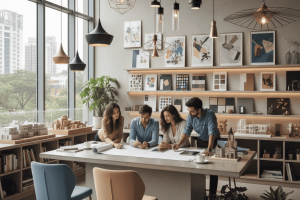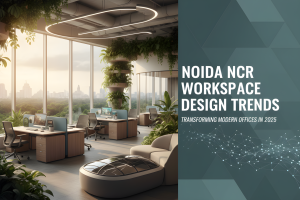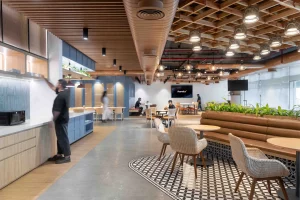10 Practical Strategies for Immediate Implementation
Starting a business forces strategic financial decisions at every turn — and your office is no exception. Many startup founders assume they must choose between affordability and professionalism; that a budget office requires sacrificing aesthetics, functionality, or employee experience. That assumption is wrong.
With intelligent planning, strategic purchasing, creative problem-solving, and a focus on essentials, you can create a professional, inspiring workspace that maximizes productivity, impresses clients, and attracts talent — all while keeping costs low. This guide walks you through 10 practical strategies with action steps, realistic budgets (in INR), ROI thinking, and an implementation timeline so you can act today.
Contents (quick jump)
- Maximize space with open, flexible layouts
- Invest in multi-functional furniture
- Leverage natural light to maximize perception
- Choose a minimalist color palette
- Incorporate biophilic design on a shoestring
- DIY projects and repurposed furniture
- Smart tech integration without premium costs
- Flexible workstations for growing teams
- Smart lighting solutions
- Dedicated breakout zones inexpensively
Budget framework | ROI math | Common mistakes to avoid | 6-week timeline | 10-point checklist | Next steps
Strategy 1: Maximize Space with Open, Flexible Layouts (₹0–5,000 for repositioning)

Every square foot must work harder in a startup. Instead of permanent walls and fixed partitions that reduce flexibility and blow budgets, adopt an open-floor-plan layout. Open plans create perceived space, improve sightlines, and encourage collaboration — essential for early-stage teams.
Implementation
Remove unnecessary barriers
- Dismantle cubicle walls or bulky dividers if present (labour cost only or free).
- Opening sightlines requires no material spend — just planning and labour.
Create distinct zones using furniture
- Use desk arrangements and tall storage units to delineate focus areas, meeting zones, and collaboration corners.
- Area rugs (neutral tones) help visually separate zones — ₹1,000–3,000 each.
- This furniture-positioning technique costs almost nothing but visually expands space. A well-placed layout can make 500 sqft feel like 650 sqft through psychological perception.
Implement modular, movable partitions
- Mobile room dividers (₹2,000–5,000 each) are an inexpensive alternative to construction.
- Glass or semi-transparent partitions maintain openness while offering acoustic privacy when needed.
- Move them as team structure or use cases evolve.
Productivity & Cost Impact
- Open layouts reduce communication friction: studies indicate 12–15% productivity improvements versus strictly partitioned cubicle environments (relative improvement depends on execution).
- Cost: ₹0–5,000 for repositioning vs ₹50,000–1,00,000+ for permanent construction.
Strategy 2: Invest in Multi-Functional Furniture (₹30,000–80,000 per person)
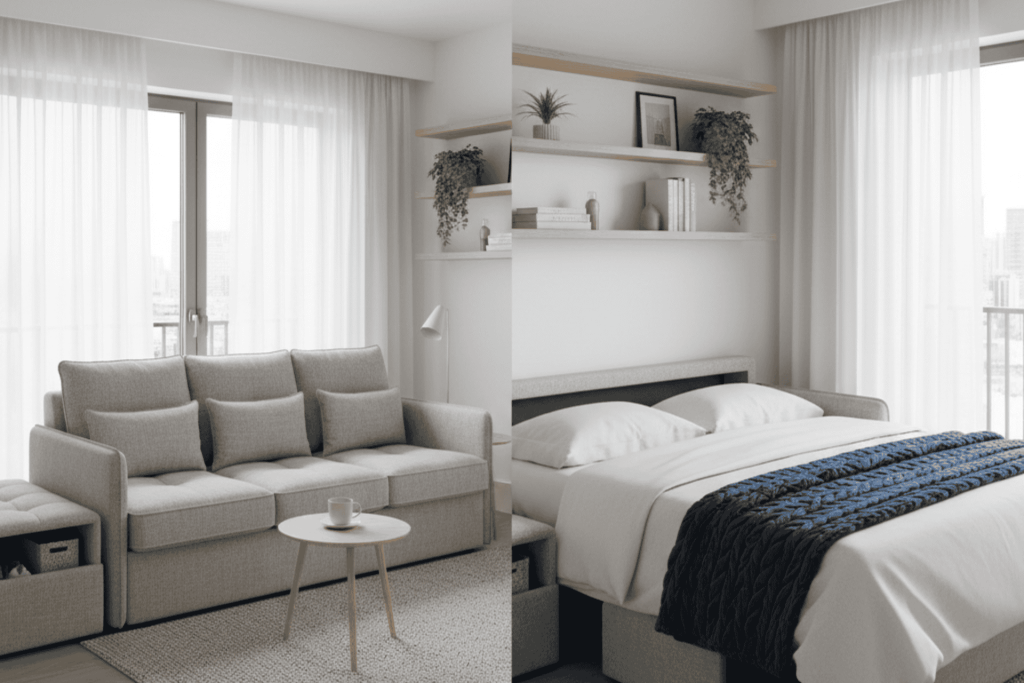
Furniture is core to functionality and aesthetics. The trick is to buy pieces that serve multiple purposes and last — not cheap disposable furniture. Multi-functional pieces save space, reduce the number of items you need, and allow easier reconfiguration.
Smart multi-functional choices
Desks with built-in storage
- Standard desk: ₹6,000–12,000
- Desk with drawers & shelving: ₹10,000–18,000
- Eliminates need for additional filing cabinets (~₹3,000–8,000 each)
- Savings: ~₹5,000–10,000 per workstation.
Foldable or nesting tables
- Nesting coffee tables: ₹2,000–5,000
- Use for client meetings, fold away afterward — one set replaces multiple tables.
Storage ottomans
- Seating + side table + hidden storage: ₹3,000–7,000
- Ideal for break areas.
Wall-mounted/fold-down desks
- Fold away when not in use (₹4,000–10,000 each) — excellent for guest desks.
The ergonomic investment (non-negotiable)
People spend 8+ hours seated. Cheap chairs produce health complaints, reduce productivity, and force replacements. Invest thoughtfully in chairs.
Typical ranges
- Budget ergonomic chairs: ₹5,000–8,000 (basic lumbar, adjustable height)
- Mid-range: ₹10,000–15,000 (better support & adjustments)
- Quality: ₹18,000–25,000 (mesh, long-life ergonomics)
ROI perspective
- Example: a ₹15,000 chair lasts 7–10 years and prevents productivity loss & health complaints; compared with a ₹3,000 chair replaced every 2–3 years, the higher-cost chair is cheaper over time.
Cost-savings example
- Standard approach: ₹80,000/person → for 10 people = ₹8,00,000
- Multi-functional approach: ₹50,000/person → for 10 = ₹5,00,000
- Immediate savings: ₹3,00,000, plus flexibility.
Strategy 3: Leverage Natural Light to Maximize Space Perception (₹0–15,000)
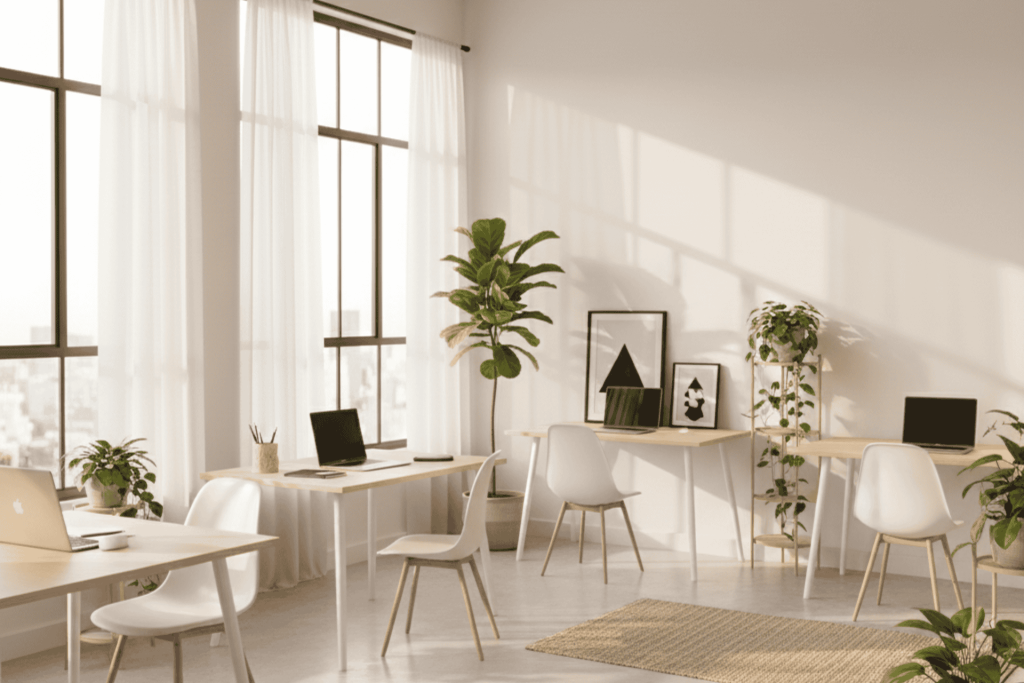
Natural light is essentially free design power — it enlarges spaces visually, uplifts mood, reduces energy use, and improves health.
Implementation
Position desks near windows
- Reorganize desk layout to maximize window access — ₹0 repositioning cost.
- Even indirect or north-facing light is superior to fluorescent-only setups.
Maximize light penetration
- Paint walls in light colors — whites, soft grays, pale pastels. Paint cost for small offices: ₹2,000–5,000.
- Avoid dark accent walls in small spaces; they absorb light and visually shrink the room.
Use mirrors strategically
- Opposite windows, mirrors reflect more light across the space. Cost: ₹500–3,000.
Prefer glass partitions
- Glass allows light to flow through; opaque walls fragment the light and feel cramped. Glass partitions cost more but are often worth it — incremental difference: ₹5,000–15,000 depending on material and size.
Minimize heavy window coverings
- Use light-filtering shades or no coverings where privacy permits. Savings: ₹3,000–8,000 vs heavy drapes.
Measurable benefits
- Energy savings: 10–15% reduction in artificial lighting needs.
- Productivity: 8–15% improvement for employees with natural light access.
- Eye health: ~20% reduction in eye-strain complaints.
Cost-benefit example
- Initial spend: ₹5,000–10,000
- Yearly lighting savings: ₹10,000–15,000
- Payback: 6–12 months plus ongoing health/productivity benefits.
Strategy 4: Choose a Minimalist Color Palette (₹2,000–8,000)
Minimalist palettes are inherently cost-effective and age better than trendy, maximalist designs.
The strategy
Base colors (choose one)
- White/off-white: brightest, large perception.
- Light gray: professional and hides dust.
- Warm beige or soft taupe: warmth without visual busyness.
Accent colors (one max)
- Use brand color sparingly — one accent wall, cushions, or a few upholstery pieces.
- Accent paint for a wall: ₹1,000–2,000.
- Small décor and cushions: ₹500–3,000.
Why this works
- Neutral palettes increase perceived space and give a clean, professional look.
- Easier & cheaper to update; you can change cushions or small accents instead of repainting.
Budget example
- Paint 1,000 sqft base + accent: ₹3,500–4,700
- Cushions + small décor: ₹2,500–3,500
- Total: ~₹8,000 (rounded) for a polished look.
Strategy 5: Incorporate Biophilic Design on a Shoestring Budget (₹3,000–15,000)
Adding nature into the office is one of the highest ROI moves you can make. Plants improve air quality, reduce stress, and boost engagement — for small spend.
Low-cost biophilic solutions
Desktop plants
- Pothos, snake plant, philodendron: ₹100–500 each.
- One per workstation (10 plants): ≈₹3,000.
Corner plants
- Larger visual anchors such as dracaena or peace lily: ₹500–2,000 each. 2–3 units = ₹3,000–5,000.
Hanging planters
- Use vertical space (₹200–1,000 each) for trailing plants.
DIY living wall
- Pallet-based planters, painted and mounted: ₹2,000–5,000. Professional living wall options run much higher.
Natural materials
- Wood desks and jute rugs add warmth; small premium but high perceived value: +₹2,000–5,000.
Maintenance options
DIY care
- Assign rotating plant care duties to staff: ₹0/month. Risks: inconsistent maintenance.
Professional service
- Monthly plant maintenance: ₹2,000–4,000. Reliable but recurring cost.
ROI calculation
- Initial plants: ₹8,000.
- Annual pro maintenance: ₹30,000 (if chosen).
- Productivity gains: ~8% for a 10-person team translates to meaningful value; payback often within months when factoring reduced absenteeism and improved output.
Strategy 6: DIY Projects and Repurposed Furniture (₹2,000–10,000)
DIY is not only cost-saving — it signals resourcefulness, builds culture, and results in unique brand-forward spaces.
Budget-friendly DIY ideas
Pallet shelving
- Free/cheap pallets (₹200–500 each) + sanding/paint: ₹700–1,500 total for shelving vs commercial shelves at ₹5,000–10,000.
Painted accent wall with geometric patterns
- Paint + tape + labour: ₹500–1,000.
Repainted second-hand furniture
- Sourcing used chairs: ₹500–2,000 each and repainting brings professional results at 40–60% discount.
Upcycled storage
- Wooden crates or old drawers stacked and painted: ₹200–1,000 total.
DIY whiteboard wall
- Whiteboard paint (100 sqft): ₹2,000–3,000 or sticky whiteboard film: ₹1,000–2,000.
Cable management
- Homemade cable boxes or channels using cardboard and paint: ₹200–500.
Psychology & branding
DIY items communicate authenticity; employees feel ownership and pride. Prospective clients often appreciate creative, founder-led spaces more than polished but soulless corporate offices.
Strategy 7: Smart Tech Integration Without Premium Costs (₹5,000–20,000)
You need tech, but not flashy or unnecessary gear. Prioritize core operations and use refurbished or cloud-based solutions.
Budget tech choices
All-in-one printer/scanner
- ₹8,000–12,000 replaces separate machines and saves space.
Refurbished equipment
- Laptops: ₹20,000–30,000 (refurb) vs ₹45,000–60,000 new.
- Monitors: ₹5,000–8,000 refurbished vs ₹10,000–15,000 new.
Cloud-first approach
- Google Workspace / Microsoft 365: per-user monthly subscriptions (₹300–600). Avoid on-premise servers.
- Cloud tools eliminate upfront IT & maintenance spend.
Open-source or low-cost alternatives
- Canva free tier, LibreOffice, Trello/Asana free tiers — use only paid tiers when scale demands.
Network basics
- Reliable router: ₹2,000–4,000 for teams of up to 15. Upgrade later to enterprise gear as you scale.
Priorities vs Avoidances
Invest first: internet, laptops, cloud backup.
Avoid early: fancy PBX phone systems, expensive AV, or custom software until product-market fit and scale justify them.
Sample 10-person tech budget
- Essential hardware: ₹80,000–1,20,000
- Monthly SaaS: ₹3,000–5,000
- Annual SaaS: ₹36,000–60,000
Strategy 8: Flexible Workstations for Growing Teams (₹8,000–15,000 per station)
Design for change. Modular desks, hot-desking, and movable storage prevent costly reworks as your team scales.
The approach
Modular desk systems
- Cost: ₹8,000–15,000 per station — slightly higher but enables reconfiguration and extension without construction.
Hot-desking (if appropriate)
- If not everyone is in-office full-time, you can reduce the number of fixed desks by 30–40%.
Furniture on casters
- Wheels for easy reconfiguration: ₹200–500 per wheelset.
Modular storage
- Stackable units allow scalable storage at lower marginal cost.
Future-proofing
- Design for your projected team size (e.g., 15 people) to avoid heavy redesigns later. This up-front flexibility saves ₹50,000–1,50,000 in renovation costs down the line.
Strategy 9: Smart Lighting Solutions (₹5,000–15,000)
Good lighting is central to employee comfort and focus. Fortunately, you can achieve professional lighting without custom installs.
Implementation
LED bulbs
- LED lasts longer and uses 70–80% less energy. Price per bulb: ₹100–200.
Task lighting
- Desk lamps: ₹800–2,000 each. Provide personal control and reduce eye strain.
Layered lighting
- Ambient ceiling lights + task lights + accent lights. This layered approach is far more comfortable than a single harsh source.
Color temperature
- 3000K–4000K recommended for offices (warm-neutral). Avoid very cool 5000K for regular desk work.
Cost & benefits
- LED investment: ₹3,000–4,000 for 20 lights.
- Task lamps: ₹8,000–15,000 for 8–10 desks.
- Energy savings: significant over 10 years; payback in ~2 years.
Strategy 10: Create Dedicated Breakout Zones Inexpensively (₹5,000–15,000)
Break spaces are not luxuries — they’re productivity tools. Even modest breakout areas pay dividends in collaboration, creativity, and employee wellbeing.
Setup ideas
Comfortable seating corner
- 2–3 used armchairs: ₹2,000–5,000 total.
- Side table: ₹500–1,500.
Coffee/tea station
- Electric kettle or basic coffee maker: ₹500–1,500.
- Small fridge: ₹5,000–8,000.
- Pallet shelving for supplies: ₹500–1,500.
Brainstorming wall
- Whiteboard paint or sticky boards: ₹1,000–3,000.
- Cork boards: ₹1,000.
Low-cost décor
- Plants, prints, and small art pieces: ₹500–2,000.
Benefits
- Short breaks restore focus; a 10–15 minute break can improve the next 2+ hours of work.
- Informal conversations spark ideas and build culture.
The Complete Budget Framework: Sample 10-Person Office (1,000 sqft) — Noida Example
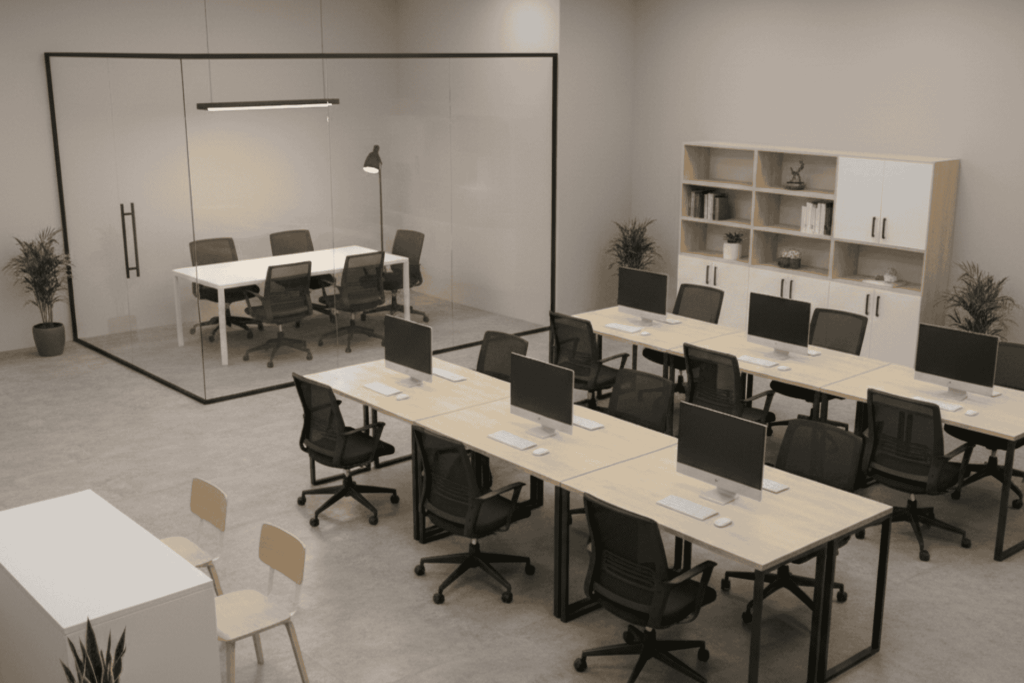
Cost Breakdown (realistic ranges)
- Furniture & Fixtures: ₹4,00,000–5,00,000
- 10 ergonomic chairs (₹12,000 each): ₹1,20,000
- 10 multi-functional desks (₹18,000 each): ₹1,80,000
- Modular storage: ₹50,000
- Meeting table: ₹30,000
- Break area seating: ₹20,000
- 10 ergonomic chairs (₹12,000 each): ₹1,20,000
- Paint, Walls, Flooring: ₹30,000–50,000
- Painting (neutral + accent): ₹5,000
- Flooring if needed: ₹20,000–40,000
- Wall décor: ₹5,000
- Painting (neutral + accent): ₹5,000
- Lighting: ₹12,000–15,000
- Ceiling LED: ₹5,000
- Task lamps: ₹8,000–10,000
- Ceiling LED: ₹5,000
- Plants & Décor: ₹10,000–15,000
- Technology: ₹1,00,000–1,50,000
- WiFi & networking: ₹10,000
- Printer: ₹10,000
- Computers/equipment (refurb/new mix): ₹60,000–1,00,000
- Tech subscriptions (annual): ₹30,000–40,000
- WiFi & networking: ₹10,000
- Miscellaneous: ₹10,000–20,000
- Signage, kitchen basics, contingency.
- Signage, kitchen basics, contingency.
Total setup cost: ₹5,50,000–7,50,000
Cost per person: ₹55,000–75,000
Cost per sqft: ₹550–750 (vs typical ₹1,200–1,500 for conventional fitouts)
ROI: Quantifying the Budget Office Investment
Many founders fear budget offices are unprofessional. The data — and experience — says the opposite: smart budget design generates measurable ROI.
1. Productivity gains
- Well-designed office → 12%–15% productivity improvement (estimated based on studies and observed workplace case studies).
- For a 10-person team with combined annual salaries of ₹50 lakh, a 12% productivity boost equals ₹60 lakh added value. The office investment (₹5–7.5 lakh) pays back extremely quickly.
2. Reduced absenteeism
- Ergonomic furniture + natural light → 8–10% fewer sick days.
- If absenteeism costs the company ₹6 lakh annually, an 8% reduction saves ₹48,000 per year.
3. Improved retention
- Better environment → 15–20% improvement in retention.
- Avoiding 1–2 departures saves recruitment & training costs (₹2–3 lakh per hire) — large savings for startups.
4. Business development
- Professional spaces improve client confidence — anecdotal increases in conversion rates (15–25% improvement in closing), which for B2B clients could mean landing higher-value contracts.
5. Recruitment advantage
- Better office reduces cost and time to hire, draws higher-quality applicants, and improves early impressions.
Net: A ₹5–7.5 lakh investment often yields multi-lakh to crore-level business value when considering productivity, hiring, client wins, and retention.
Common Mistakes to Avoid (so your budget doesn’t backfire)
- Buying cheap, replace-soon furniture
- Saves small amounts upfront and costs far more in dissatisfaction and replacements.
- Saves small amounts upfront and costs far more in dissatisfaction and replacements.
- Sacrificing ergonomics
- Uncomfortable workstations reduce productivity 15–20% and increase sick leave.
- Uncomfortable workstations reduce productivity 15–20% and increase sick leave.
- Over-decorating without function
- Visual clutter can reduce usable space and attention.
- Visual clutter can reduce usable space and attention.
- Neglecting natural light
- Artificial lighting-only spaces cause mood and health issues.
- Artificial lighting-only spaces cause mood and health issues.
- Designing without growth in mind
- Rigid design forces expensive reworks when hiring.
- Rigid design forces expensive reworks when hiring.
- Skipping a break space
- Teams without rest areas suffer in creativity and morale.
- Teams without rest areas suffer in creativity and morale.
- Mixing too many styles
- Incohesive furniture styles look chaotic rather than “eclectic”.
- Incohesive furniture styles look chaotic rather than “eclectic”.
- Buying tech toys before basics
- Prioritize chairs & desks before premium conference room AV.
- Prioritize chairs & desks before premium conference room AV.
Implementation Timeline: 6-Week Startup Office Setup
Week 1–2: Planning & Procurement
- Measure exact space.
- Define immediate headcount and 12-month projection.
- Create budget allocation and shortlist suppliers (3 quotes).
- Finalize color palette & materials.
Week 3: Foundation Work
- Paint (neutral base + accent) and basic electrical/lighting installs.
- Deep clean the space.
- Set up internet & core tech infrastructure.
Week 4: Furniture Delivery & Assembly
- Deliver modular furniture.
- Assemble workstations and meeting setups.
Week 5: Biophilic & Décor
- Place plants, hang planters, install whiteboard and inspiration wall.
- Finalize break area.
Week 6: Testing & Refinement
- Team move-in; solicit feedback and iterate on layout and settings.
- Make minor changes and host an official launch.
Key Takeaways: The 10-Point Checklist
✓ Maximize Space: open layouts, smart furniture placement.
✓ Multi-Functional: every piece should serve two or more uses.
✓ Natural Light: prioritize windows and reflective surfaces.
✓ Minimalist Palette: neutral base + one accent color.
✓ Biophilic: plants for air quality and mood.
✓ DIY: repurpose and upcycle where appropriate.
✓ Smart Tech: essentials only; cloud-first.
✓ Flexible Design: modular systems for growth.
✓ Quality Lighting: LED + task lamps.
✓ Break Spaces: invest in a small, real breakout area.
Next Steps: How to Move Forward This Week
- Measure your office (get exact sqft and window placements)
- Decide on immediate headcount and 12-month plan (design for where you’ll be, not just today)
- Request 3 quotes for modular desks, ergonomic chairs, and lighting from local suppliers
- Select 2 DIY projects (pallet shelving, painted accent wall) to cut costs and build team ownership
- Pick 8–10 plants and schedule either DIY maintenance or one month trial with a plant service
- Order 3 key ergonomic chairs first and set them up to get immediate impact on team comfort
Final Perspective: Why Budget Offices Often Outperform Expensive Ones
Budget-conscious offices force prioritization. By spending deliberately on ergonomics, light, collaboration spaces, and flexibility, you get a high-functioning workspace that signals resourcefulness. Teams respect founder-led resourcefulness. Clients sense authenticity. Careful design, not high cost, creates a lasting culture and measurable ROI.


